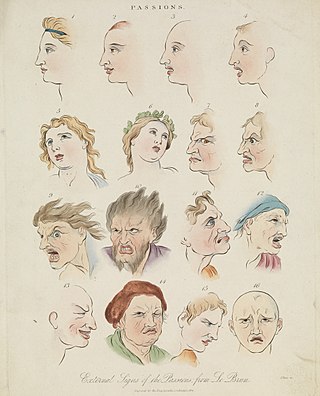Related Research Articles

Emotions are mental states brought on by neurophysiological changes, variously associated with thoughts, feelings, behavioral responses, and a degree of pleasure or displeasure. There is currently no scientific consensus on a definition. Emotions are often intertwined with mood, temperament, personality, disposition, or creativity.

Fear is an intensely unpleasant emotion in response to perceiving or recognizing a danger or threat. Fear causes physiological changes that may produce behavioral reactions such as mounting an aggressive response or fleeing the threat. Fear in human beings may occur in response to a certain stimulus occurring in the present, or in anticipation or expectation of a future threat perceived as a risk to oneself. The fear response arises from the perception of danger leading to confrontation with or escape from/avoiding the threat, which in extreme cases of fear can be a freeze response or paralysis.

The Milgram experiment(s) on obedience to authority figures were a series of social psychology experiments conducted by Yale University psychologist Stanley Milgram. They measured the willingness of study participants, 40 men in the age range of 20 to 50 from a diverse range of occupations with varying levels of education, to obey an authority figure who instructed them to perform acts conflicting with their personal conscience. Participants were led to believe that they were assisting an unrelated experiment, in which they had to administer electric shocks to a "learner". These fake electric shocks gradually increased to levels that would have been fatal had they been real.

Stanley Milgram was an American social psychologist, best known for his controversial experiments on obedience conducted in the 1960s during his professorship at Yale.

Humour or humor is the tendency of experiences to provoke laughter and provide amusement. The term derives from the humoral medicine of the ancient Greeks, which taught that the balance of fluids in the human body, known as humours, controlled human health and emotion.
Feelings are subjective self-contained phenomenal experiences. According to the APA Dictionary of Psychology, a feeling is "a self-contained phenomenal experience"; and feelings are "subjective, evaluative, and independent of the sensations, thoughts, or images evoking them". The term feeling is closely related to, but not the same as emotion. "Feeling" may for instance refer to the conscious subjective experience of emotions. The study of subjective experiences is referred to as phenomenology. The discipline of psychotherapy generally involves a therapist helping a client understand, articulate and learn to effectively regulate their own feelings and ultimately take responsibility for their experience of the world. Feelings are sometimes held to be characteristic of embodied consciousness.

Shyness is the feeling of apprehension, lack of comfort, or awkwardness especially when a person is around other people. This commonly occurs in new situations or with unfamiliar people; a shy person may simply opt to avoid these situations. Although shyness can be a characteristic of people who have low self-esteem, the primary defining characteristic of shyness is a fear of what other people will think of a person's behavior. This fear of negative reactions such as being laughed at, humiliated or patronized, criticized or rejected can cause a shy person to retreat. Stronger forms of shyness can be referred to as social anxiety or social phobia.
Laughter is a pleasant physical reaction and emotion consisting usually of rhythmical, often audible contractions of the diaphragm and other parts of the respiratory system. It is a response to certain external or internal stimuli. Laughter can rise from such activities as being tickled, or from humorous stories or thoughts. Most commonly, it is considered an auditory expression of a number of positive emotional states, such as joy, mirth, happiness, or relief. On some occasions, however, it may be caused by contrary emotional states such as embarrassment, surprise, or confusion such as nervous laughter or courtesy laugh. Age, gender, education, language, and culture are all indicators as to whether a person will experience laughter in a given situation. Some other species of primate show laughter-like vocalizations in response to physical contact such as wrestling, play chasing or tickling.

Tickling is the act of touching a part of a body in a way that causes involuntary twitching movements or laughter. The word "tickle" (help·info) evolved from the Middle English tikelen, perhaps frequentative of ticken, to touch lightly.
Obedience, in human behavior, is a form of "social influence in which a person yields to explicit instructions or orders from an authority figure". Obedience is generally distinguished from compliance, which is behavior influenced by peers, and from conformity, which is behavior intended to match that of the majority. Depending on context, obedience can be seen as moral, immoral, or amoral.
In the fields of sociology and social psychology, a breaching experiment is an experiment that seeks to examine people's reactions to violations of commonly accepted social rules or norms. Breaching experiments are most commonly associated with ethnomethodology, and in particular the work of Harold Garfinkel. Breaching experiments involve the conscious exhibition of "unexpected" behavior/violation of social norms, an observation of the types of social reactions such behavioral violations engender, and an analysis of the social structure that makes these social reactions possible. The idea of studying the violation of social norms and the accompanying reactions has bridged across social science disciplines, and is today used in both sociology and psychology.
Coping refers to conscious strategies used to reduce unpleasant emotions. Coping strategies can be cognitions or behaviours and can be individual or social.
Under the controversy of person–situation debate, situationism is the theory that changes in human behavior are factors of the situation rather than the traits a person possesses. Behavior is believed to be influenced by external, situational factors rather than internal traits or motivations. Situationism therefore challenges the positions of trait theorists, such as Hans Eysenck or Raymond B. Cattell. This is an ongoing debate that has truth to both sides; psychologists are able to prove each of the view points through human experimentation.
Test anxiety is a combination of physiological over-arousal, tension and somatic symptoms, along with worry, dread, fear of failure, and catastrophizing, that occur before or during test situations. It is a physiological condition in which people experience extreme stress, anxiety, and discomfort during and/or before taking a test. This anxiety creates significant barriers to learning and performance. Research suggests that high levels of emotional distress have a direct correlation to reduced academic performance and higher overall student drop-out rates. Test anxiety can have broader consequences, negatively affecting a student's social, emotional and behavioural development, as well as their feelings about themselves and school.

The sociology of emotion applies sociological theorems and techniques to the study of human emotions. As sociology emerged primarily as a reaction to the negative effects of modernity, many normative theories deal in some sense with emotion without forming a part of any specific subdiscipline: Karl Marx described capitalism as detrimental to personal 'species-being', Georg Simmel wrote of the deindividualizing tendencies of 'the metropolis', and Max Weber's work dealt with the rationalizing effect of modernity in general.
Social anxiety is the anxiety and fear specifically linked to being in social settings. Some categories of disorders associated with social anxiety include anxiety disorders, mood disorders, autism spectrum disorders, eating disorders, and substance use disorders. Individuals with higher levels of social anxiety often avert their gazes, show fewer facial expressions, and show difficulty with initiating and maintaining a conversation. Social anxiety commonly manifests itself in the teenage years and can be persistent throughout life, however, people who experience problems in their daily functioning for an extended period of time can develop social anxiety disorder. Trait social anxiety, the stable tendency to experience this anxiety, can be distinguished from state anxiety, the momentary response to a particular social stimulus. Half of the individuals with any social fears meet the criteria for social anxiety disorder. Age, culture, and gender impact the severity of this disorder. The function of social anxiety is to increase arousal and attention to social interactions, inhibit unwanted social behavior, and motivate preparation for future social situations.

Humor research is a multifaceted field which enters the domains of linguistics, history, and literature. Research in humor has been done to understand the psychological and physiological effects, both positive and negative, on a person or groups of people. Research in humor has revealed many different theories of humor and many different kinds of humor including their functions and effects personally, in relationships, and in society.
The State-Trait Anxiety Inventory (STAI) is a psychological inventory consisting of 40 self-report items on a 4-point Likert scale. The STAI measures two types of anxiety – state anxiety and trait anxiety. Higher scores are positively correlated with higher levels of anxiety. Its most current revision is Form Y and it is offered in more than 40 languages.

In psychology, stress is a feeling of emotional strain and pressure. Stress is a type of psychological pain. Small amounts of stress may be beneficial, as it can improve athletic performance, motivation and reaction to the environment. Excessive amounts of stress, however, can increase the risk of strokes, heart attacks, ulcers, and mental illnesses such as depression and also aggravation of a pre-existing condition.
Humor styles are a subject of research in the field of personality psychology that focuses on the ways in which individuals differ in their use of humor. People of all ages and cultures respond to humor, but their use of it can vary greatly. There are multiple factors, such as culture, age, and political orientation, that play a role in determining what people find humorous. Although humor styles can be somewhat variable depending on social context, they tend to be a relatively stable personality characteristic among individuals. Humor can play an instrumental role in the formation of social bonds, enabling people to relate to peers or to attract a mate, and can help to release tension during periods of stress. There is a lack of current, reliable research that explores the impact of humor usages on others because it is difficult to distinguish a healthy humor usage from one that is unhealthy. Justifications for harmful versus benign humor styles are subjective and lead to varying definitions of either usage.
References
- ↑ Provine, Robert R. (1996). "Laughter". American Scientist. Jan-Feb 1996. Archived from the original on 21 June 2012. Retrieved 8 May 2012.
- 1 2 Lickerman, Alex. "Why We Laugh". Psychology Today. Retrieved 12 May 2011.
- ↑ Balandis, M. (2010). "Psychology studies". Nervous Laughter. Lithuania.
- ↑ Hockenbury, Don (2011). Discovering Psychology. New York, NY: Worth Publishers.